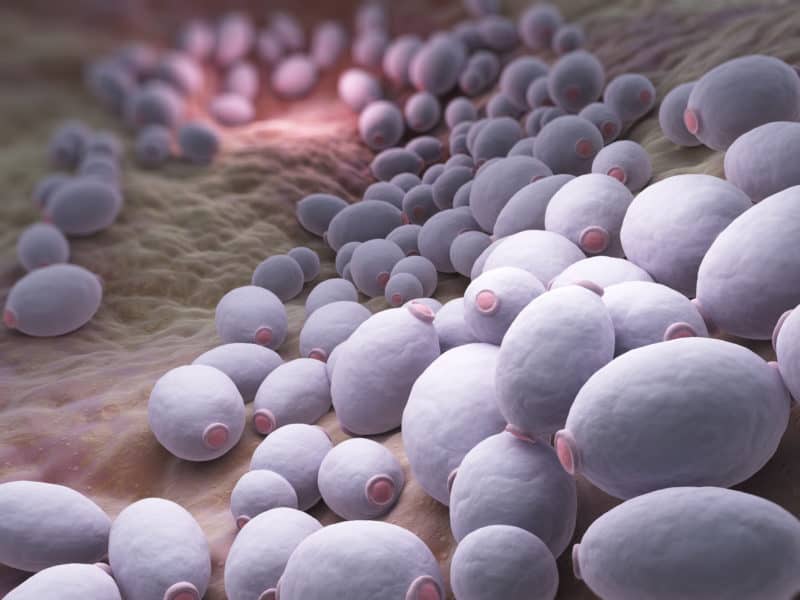

More and more I’m seeing patients in my office who have candida overgrowth. It’s now become one of the most common conditions I treat. Fortunately, there’s a lot that can be done to combat candida and restore balance naturally.
Candida albicans is a type of yeast, that you always have in your body – your mouth, gastrointestinal tract, skin, and if you’re a woman, in your vagina. When you’re healthy, this extremely common yeast is kept in check and doesn’t cause any problems. However, if you’re eating a lot of sugar, taking antibiotics, steroids, or have a high stress lifestyle candida can become a problem.
Candida isn’t all bad. You need some to help your body with nutrient absorption and effective digestion. However, when it becomes a problem it can be very serious. In fact, candida can enter the bloodstream and infect internal organs. Candidiasis is the third most common bloodborne infection in the United States.
Unlike other microbe imbalances candida overgrowth symptoms can remain mild for a while, which means it can take some time for you to achieve a diagnosis. Exactly how candida presents can differ from person to person but there are a couple of unique telltale signs that set a candida diagnosis apart from other conditions.
Top 15 Most Common Candida Symptoms
Symptoms range from mildly frustrating to debilitating but what usually brings someone in for an appointment is the extreme fatigue and brain fog. Sometimes they don’t realize other factors are actually symptoms of candida because they can be so mild – such as bad breath.
If you’re experiencing three or more of the following, you might have candida overgrowth.
- Oral thrush – Characterized by a white coating on your tongue.
- Craving sugar – Excessive sugar consumption is a major contributor to candida overgrowth, which then causes sugar cravings. This can become a vicious cycle.
- Bad breath – Bad breath is one of the first and more mild symptoms of candida overgrowth. If you can’t seem to get rid of your bad breath with normal oral hygiene you should consider the possibility of oral dysbiosis caused by candida.
- Brain fog – Brain fog is one of the symptoms that brings most people into my office. Candida can make it difficult to get through the day and complete normal tasks.
- Exhaustion – Chronic fatigue is one of the most common symptoms and can develop into chronic fatigue syndrome if left unchecked.
- Joint pain – Candida can cause arthritis when it enters your bloodstream and infects the joints. This is actually called candida arthritis.
- Low libido – Low libido is a common sign that often goes unrealized until a candida diagnosis is made.
- Hormone imbalance – This can manifest in many ways such as early menopause, endometriosis, mood swings, and painful PMS symptoms. This is a symptom that patients often don’t realize is due to candida.
- Allergies – These can be due to the rampant inflammation in the body. Cytokines and candida antibodies can create new sensitivities.
- Sinus infections – One study found that 96 percent of people tested with sinus infections had fungus in their mucus, which was believed to be to blame.
- Digestive issues – Candida overgrowth starts in the gut so it’s no surprise it can cause all sorts of gastrointestinal issues. If left unchecked candida can contribute to Crohn’s disease and ulcerative colitis.
- Skin conditions, such as psoriasis and eczema – Other common symptoms many don’t realize are due to microbial imbalance. Many people with skin conditions end up with prescriptions for creams that don’t address the root causes and therefore don’t offer long term solutions.
- Poor immune system health – Because candida causes widespread inflammation it can throw your immune system off, which may make diagnosis more difficult.
- Recurring urinary tract infections – These are especially common in women.
- Fungal infections of the skin and nails – If you can’t seem to get rid of a fungal infection of the skin or nails, you should definitely be checked for candida overgrowth.
If candida remains an issue for a long period of time, it’s been shown to have serious negative effects on the psychology – even contributing to mental illness, attention deficit/hyperactivity disorder (ADHD), anxiety, stress, and mood disorders.
Candida overgrowth has also been associated with inflammatory bowel disease and can lead to hospitalization in severe cases. One thing is for certain, it’s always better to catch the signs of an imbalance early. This is why I encourage you to never ignore symptoms such as brain fog and chronic bad breath. Every change in your body is a sign – a way for your body to communicate with you about how it’s doing.
How Do You Get Candida?
Candida isn’t something you catch – you always have some candida in your body. Instead, lifestyle factors cause this yeast to overproduce or grow unchecked. Factors that can cause a candida overgrowth include:
- Antibiotics
- A weak immune system
- High stress life
- Eating a lot of sugars or refined carbs
- Drinking a lot of alcohol
- Birth control
- Certain medical conditions, such as steroids
- Cancer or immunosuppressive treatments
Natural Candida Treatments
To successfully treat candida you’ll need to work on healing your gut. Firstly, through eliminating damaging foods, toxins, and medications. Next, with a powerful, healing diet you can work to restore the balance to your gut. I recommend my 30-day Paleo Reset diet – this will give you a jumpstart on healing your body and eliminating candida.
Probiotics can help restore balance. Especially, Lactobacillus because these strains inhibit the growth of pathogens and are especially effective against the candida.
Additionally, certain incorporating certain foods in your diet can help stave off candida overgrowth. These include:
- Garlic
- Coconut oil
- Turmeric
- Oregano
Get tested! See your functional medicine physician to get the proper test to diagnose a candida overgrowth. The symptoms of candida overgrowth overlap with other illnesses, so it is important to have a correct diagnosis before beginning a treatment protocol. Tests may include an organic acids test and/or a comprehensive stool analysis, and possibly blood work or a sinus culture.
Don’t ignore the early warning signs of candida overgrowth – when you catch it early it is often easier to treat!
Resources:
https://www.ncbi.nlm.nih.gov/pmc/articles/PMC3134095/
https://www.ncbi.nlm.nih.gov/pmc/articles/PMC4742637/
https://www.sciencedaily.com/releases/1999/09/990910080344.htm
https://www.ncbi.nlm.nih.gov/pmc/articles/PMC3163673/
https://www.ncbi.nlm.nih.gov/pubmed/23784606
https://www.ncbi.nlm.nih.gov/pubmed/23962107
https://www.ncbi.nlm.nih.gov/pubmed/21672043
Share:
Social Media
Most Popular Posts


Progesterone Therapy In Perimenopause

Different Ways To Replace Estrogen in Menopause

Subscribe To Our Newsletter
Related Posts

Testosterone Replacement In Menopause
What about adding testosterone replacement for women on hormone replacement therapy? Well, it can be really, really helpful for energy, libido, body composition changes. When

Progesterone Therapy In Perimenopause
What about progesterone therapy in menopause? So if you are on hormone replacement therapy with estrogen and you have a uterus, meaning you have not

Different Ways To Replace Estrogen in Menopause
When doing hormone replacement therapy for women, there are about four different ways we can get hormones into the body, especially estrogen. So our estrogens

Microplastic Exposure and Health: How Microplastics in Food Affect Health
In our modern world, plastics are all around us. Because they have poor biodegradability and are often not efficiently recycled, our environment is contaminated with
